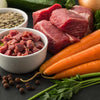Understanding What Is in Raw Dog Food: A Comprehensive Guide
- Houndsy
Table of Contents
- Introduction
- What Constitutes a Raw Dog Food Diet?
- Popular Raw Feeding Philosophies
- Nutritional Benefits and Considerations
- Understanding the Risks
- The Importance of a Balanced Raw Diet
- Making the Transition
- Homemade Raw Dog Food vs. Commercial Options
- Key Takeaways and Final Thoughts
- FAQ Section
Introduction
Imagine stepping into the kitchen and crafting a meal brimming with the freshest, most nutritious ingredients, not just for yourself but for your best four-legged friend. Sounds appealing, right? A recent survey found that nearly 25% of dog owners are considering a raw dog food diet to elevate their pets' nutrition. Yet, with varied opinions and debates surrounding raw diets, the essential question remains: What is in raw dog food, and should we consider it for our pets?
In today's dog food landscape, many pet owners are reexamining what they feed their furry companions. As advocates of better dog care, we at Houndsy believe that understanding your pet's nutrition is paramount. This comprehensive guide aims to demystify raw dog food, detailing its ingredients, benefits, risks, and practical considerations to help you make informed choices for your canine family members.
As we delve deeper, we'll examine the core components of raw dog food, various feeding philosophies, and critical insights into balancing nutrition. Whether you're contemplating transitioning to a raw diet or just curious about what goes into it, this post is designed for you. By the end, we hope to empower you with knowledge about what truly nourishes your dog while also introducing our innovative feeding solution, the Houndsy Kibble Dispenser, which complements any meal plan beautifully.
Let’s embark on this journey of understanding raw dog food.
What Constitutes a Raw Dog Food Diet?
A raw dog food diet primarily consists of unprocessed ingredients, which may include:
- Raw Meat: This can encompass various muscle and organ tissues from animals. It is advocated as the primary component.
- Bones: Many raw diets include whole or ground bones, believed to provide essential calcium and phosphorus.
- Organs: Liver and other internal organs are crucial as they offer dense sources of vitamins and minerals.
- Fruits and Vegetables: Though dogs are primarily carnivorous, many raw feeding advocates incorporate fruits and vegetables for added nutrition.
- Dairy and Eggs: Occasionally, raw diets may include foods like yogurt or eggs to provide crucial nutrients, such as fatty acids and proteins.
These components vary based on the feeding philosophy adopted by the pet owner. Let's break down these philosophies to explore how they shape the raw diet.
Popular Raw Feeding Philosophies
The Prey Model
The Prey Model aims to mimic a dog's natural diet as it would exist in the wild, focusing primarily on:
- 80% Muscle Meat: This is the main protein source.
- 10% Bone: Providing vital minerals.
- 10% Organs: Half of which should be liver, ensuring essential vitamin intake.
Supporters of this approach argue that by emulating the natural prey of wild canines, this diet allows dogs to access the nutrients found in both muscle and organ meats without any unnecessary fillers.
The BARF Diet
An acronym for Biologically Appropriate Raw Food, the BARF diet was popularized by Australian veterinarian Ian Billinghurst in the early 1990s. It seeks to replicate what dogs would naturally hunt and consume. The BARF diet typically comprises:
- 70% Muscle Meat
- 10% Raw Edible Bone
- 5% Liver
- 5% Other Organ Meats
- 7% Vegetables
- 2% Seeds or Nuts
- 1% Fruits
This more diversified approach includes vegetables and seeds, thought by some to provide fiber and additional nutrients that dogs would otherwise miss. It accommodates a broader variety of ingredients while focusing on the nutritional profiles observed in nature.
Nutritional Benefits and Considerations
Transitioning to a raw dog food diet invites numerous health benefits, but it's also essential to understand the nutritional aspects. Here are some advantages:
Enhanced Digestion
Raw diets generally facilitate easier digestion for dogs. Unlike processed kibble, which often contains fillers and undergoes cooking that damages nutrients, raw food retains its natural enzymes. When diets are easily digestible, dogs tend to have smaller, less odorous stools.
Improved Coat and Skin Health
Many pet owners report shinier coats and healthier skin after switching to raw. The high-fat content in raw diets, particularly omega fatty acids from meats and added oils, contributes to a vibrant, healthy coat. By ensuring a balanced intake of essential nutrients, raw diets can help mitigate skin conditions.
Increased Energy Levels
Pet parents often observe heightened energy in their dogs following a transition to a raw diet. This can be attributed to a proper balance of proteins and reduced sugars compared to traditional kibbles, leading to stable energy levels without sudden spikes and crashes.
Disease Prevention
Several holistic veterinarians advocate that a balanced raw diet may lower the risk of chronic diseases like obesity and diabetes. The high protein and lower carb ratios can help regulate weight, thereby reducing potential health problems stemming from obesity.
Understanding the Risks
Despite the benefits, there are risks associated with a raw dog food diet that must not be overlooked:
Bacterial Contamination
Raw meats pose a risk of harboring harmful bacteria, like Salmonella or E. coli. Pet owners must practice safe food-handling procedures, such as thorough handwashing after handling raw food and keeping kitchen surfaces clean. The FDA advises using caution and proper hygiene when feeding raw diets.
Nutritional Imbalances
Feeding a raw diet without precise knowledge can lead to nutritional deficiencies or excesses. Most dog owners may overlook the required balance of vitamins and minerals, leading to potential health complications over time. Consulting with a veterinarian or pet nutritionist is crucial to developing a well-rounded meal plan.
Potential for Choking or Internal Injuries
Choosing to feed whole bones raises concerns about choking hazards or internal injuries. While raw bones can be beneficial for dental health, pet owners should always supervise their pets and ensure they’re of appropriate size and type.
The Importance of a Balanced Raw Diet
When creating a raw diet, balance is critical. It's more than just mixing meats and bones. A thoughtful blend should include:
- A variety of meats to ensure healthy protein intake.
- Fruits and vegetables to provide fiber and antioxidants.
- Essential fatty acids for skin and coat health.
- A mix of organ meats to supply necessary vitamins.
We can, therefore, see that transitioning to a raw dog food diet is not merely an aesthetic choice; it’s about holistic health and nutrition. As responsible pet owners, we should aim to create balanced meals that meet our dogs’ specific needs, especially as they age or change in activity levels.
Making the Transition
Changing your dog’s diet to raw should be a gradual process. Here’s a suggested plan:
- Start Slow: Begin by introducing raw food alongside their normal diet. This might mean adding small amounts of raw meat to kibble to acclimate their system.
- Monitor Responses: Watch your dog for any signs of digestive upset or allergic reactions. This will help you catch any potential issues early.
- Consult a Professional: Given the complexities associated with balanced nutrition, we recommend working with a certified animal dietician or a holistic veterinarian who can help design a tailored raw feeding plan.
At Houndsy, we believe that feeding is not just a necessity—it’s a cherished moment. That's why we've designed our Houndsy Kibble Dispenser to complement every feeding routine, providing convenience and style.
Homemade Raw Dog Food vs. Commercial Options
For pet parents deciding against commercial raw dog food options, the homemade route offers flexibility and control over ingredient sources. However, this comes with its challenges. Homemade options require:
- Research for Balance: Understanding your dog's nutritional needs is essential to preventing deficiencies.
- Quality Ingredients: Sourcing high-quality, fresh ingredients can become expensive and time-consuming.
- Time Commitment: Preparing meals from scratch requires consistent effort and organization.
Conversely, many commercial raw food options are available on the market that meet dietary requirements set by organizations like AAFCO. They offer pre-packaged meals formulated for specific age groups and conditions, saving time and effort for busy pet owners.
Key Takeaways and Final Thoughts
Understanding what is in raw dog food is crucial for any pet owner considering this dietary shift. The rewards can be significant, leading to healthier, happier pets. However, this comes with responsibility: balanced nutrition, safe handling practices, and ongoing education are vital components of a successful raw feeding strategy.
For pet parents keen on refining their dog’s feeding experience without compromising aesthetics, consider exploring our Houndsy Kibble Dispenser. This stylish solution offers precise portioning, ergonomically designed convenience, and complements the beauty of your home.
FAQ Section
Is raw dog food safe for my pet?
While many dogs thrive on raw diets, safety precautions are critical. Ensure that the food is handled with care to prevent bacterial contamination. Consulting a veterinarian before making dietary changes is always best.
How can I ensure a balanced raw diet for my dog?
Consulting a certified pet nutritionist can help ensure your dog receives a well-rounded diet rich in necessary nutrients, including proteins, vitamins, and healthy fats.
What if my dog is sensitive to certain proteins?
If your dog has allergies or intolerances, it’s essential to work with a veterinarian to identify suitable protein sources and customize a raw feeding plan.
Can raw dog food improve my dog’s dental health?
Yes! Raw bones can aid in cleaning teeth and promoting healthy gums during chewing. However, ensure the bones are appropriate for size and type to avoid any risks.
By understanding what’s in raw dog food and how it aligns with our commitment to innovative pet care, we can make informed choices that enhance the lives of our furry companions. Let's cherish those feeding moments together!












